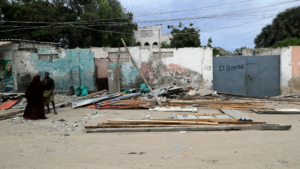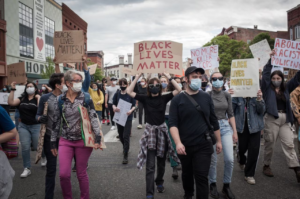Every Congressional session for nearly three decades, the late Democratic Rep. John Conyers of Michigan introduced HR 40, calling for a national commission to study the impact of slavery and discriminatory policies on African Americans and to recommend remedies, including reparations.
The measure languished until earlier this year, when a House committee voted to advance it to the floor for an eventual vote. Notable as the victory was, such a commission is likely years away from becoming law. A national reparations program, if ever approved, is even more distant.
But Black activists and residents in the Kansas City area have begun discussing reparations at the local level, exploring ways in which government, business and society could provide compensation for past harm and injustice within the metro.
“In addition to the role of the federal government, we think local institutions as well as the state itself have played a role” in past wrongs, said Mickey Dean, a retired deputy director of the Kansas City Human Relations Department who is involved in the effort.
A growing number of cities are talking about and advancing programs to address past harm to Black residents. The initiatives are intended to help close wealth gaps and other disparities created by decades of anti-Black racism, including redlining, Jim Crow laws and, before that, the enslavement of Black people.
Evanston, Illinois, in March became the first U.S. city to approve a reparations program for qualifying Black households, which will receive $25,000 for home repairs or down payments on property. The Chicago suburb plans to put $10 million toward the effort over the next decade.
Other cities — including Providence, R.I., Asheville, N.C., and Amherst, Mass. — have either approved their own programs or are weighing proposals. This is going forward even as strong disagreement exists among scholars and activists about whether these initiatives, which can be limited in scope, should be called reparations.
Mayor Quinton Lucas is among the urban leaders exploring how reparations might work locally.
“Mayor Lucas has been engaging in discussions about reparations with several of his mayoral colleagues from around the country, and momentum is building for a coalition that will examine possible means of reparations in the near future,” spokesperson Morgan Said said.
Lawmakers in several states have also proposed reparations studies. California has established a task force to examine the issue. Similar efforts seem unlikely in the near future in Missouri, where legislators considered banning schools from teaching the 1619 Project, which places “the consequences of slavery and the contributions of Black Americans at the very center of our national narrative.”
The Kansas City Council voted on April 8 to go on-record supporting HR 40. But while it awaits further action in Congress, momentum is building in the metro.
Justice Horn, a Kansas City activist and candidate for the Jackson County Legislature, said government at all levels has a role to play in “being an equalizer in the community.”
“When you look at where Kansas City is today, Black Kansas Citians, the longer we stay in our current state the worse things are gonna get,” Horn said.
UNDERSTANDING PAST HARM
In Kansas City, discussions appear to be at a very early stage. A collection of local groups, which includes the Southern Christian Leadership Conference, the National Black United Front and NAACP, have been meeting monthly since last fall, said Dean.
The coalition is divided into subcommittees examining homeownership/affordable housing, education, economics/business development, health and criminal justice, he said.
“What we’re trying to do, on the one hand, is really articulate the harm in all of those areas that really has taken place in our community. And two, to determine who is responsible, what institutions are historically responsible,” Dean said, adding they will then decide what reparative measures should be sought.
Fully understanding the scale of past harm, let alone assigning a value to it, could prove difficult. But even the roughest, most incomplete of estimates show past actions and policies exacted a staggering financial cost.
Take redlining, for example.
An analysis of redlining — the practice of refusing loans or insurance to someone based on where they live — demonstrates how predominantly white Kansas Cityneighborhoods were given the most favorable designations by the Home Owners Loan Corporation, a federally-sponsored agency created under the New Deal in the 1930s. Today, those communities are much more financially prosperous than Black neighborhoods that received the lowest grades. Maps produced by HOLC marked the least-favorable areas with red ink.
The study by Strong Towns, an organization focused on rethinking city development, and Urban3, a data analytics firm, show that financial productivity is about $1.9 million an acre per year in the best-ranked areas, compared to $175,000 in redlined communities, an annual gap of 1,100%.
“That’s 11 times more wealth, 11 times more tax revenue, from the federally-supported zone than the redlined area. And that is just one year; the community has experienced this self-inflicted loss of capacity year over year for more than eight decades,” wrote Charles Marohn, the president of Strong Towns.
In Kansas City, Kan., the same analysis estimated redlining’s role in keeping lots vacant in a single 1/2 square mile area had cost more than $30 million in tax revenue since 1937.
At a national scale, the costs are even larger. William Darity, a professor of public policy at Duke University, estimates the value of reparations nationally at about $11 trillion. It’s the amount he says would be necessary to close the wealth gap between Black and white Americans. Black Americans with ancestors who were enslaved represent about 12% of the population, but hold less than 2% of the nation’s wealth, he has said.
Darity defines reparations as including three components. First, harm must be acknowledged. Second is redress, where victimized individuals and communities are compensated. The last element is closure, when an agreement is reached and the debt has been paid.
The local initiatives currently receiving attention across the country, while well-intended, don’t constitute reparations, Darity said. The federal government should be the culpable party bearing the costs.
“Certainly, if you set as your goal elimination of the racial wealth gap, it’s virtually impossible for localities and state governments to actually engage in reparations proper,” Darity said.
In 2017, spending by state and local governments totaled $3.1 trillion, according to the Urban Institute. They would have to devote the entirety of their budgets for years to approach the $11 trillion Darity says is needed.
“This is absolutely unrealistic,” Darity said. “So people talk about local actions or initiatives as reparations in light of an objective of eliminating the racial wealth gap, then they’re just engaged in mystification.”
The United States and other countries have paid reparations before but not a similar scale. Japanese Americans interned during World War II and their heirs received $20,000 checks at a total cost of about $1.6 billion. Germany has paid victims of the Holocaust about $80 billion, as recently as 2020 to aid survivors during the pandemic.
Read more here: https://www.kansascity.com/news/politics-government/article252053428.html#storylink=cpy




